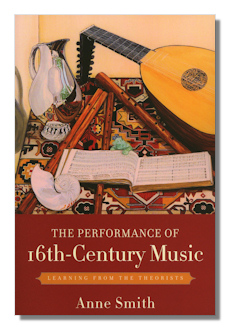
The Internet's Premier Classical Music Source
Related Links
-
Introduction
Acoustics
Ballet
Biographies
Chamber Music
Composers & Composition
Conducting
Criticism & Commentary
Discographies & CD Guides
Fiction
History
Humor
Illustrations & Photos
Instrumental
Lieder
Music Appreciation
Music Education
Music Industry
Music and the Mind
Opera
Orchestration
Reference Works
Scores
Thematic Indices
Theory & Analysis
Vocal Technique
Search Amazon
Recommended Links
Site News
 Book Review
Book Review
The Performance of 16th-Century Music

Learning from the Theorists
Anne Smith
Oxford University Press, 2011 pp x + 244
ISBN-10: 0199742618
ISBN-13: 978-0199742615
Examinations of performance practice (for "early" as well as for any other period of music) will probably always be written. And rightly so. New research, new documents, new insights – and above all new performing experiences – will and should continue to inform the ways we make and listen to music. The subtitle of this excellent new book by Anne Smith is Learning from the Theorists; this perhaps undersells its erudition and perceptiveness – as though Smith herself were being handed someone else's "lessons". Not a bit of it. The Performance of 16th-Century Music is packed with sound, scholarly, tried-and-tested ideas, principles and highly illuminating suggestions. Suggestions chiefly for performers, admittedly; but most of great relevance to anyone involved in any way with music of the sixteenth century. The book has much greater depth than a manual; more breadth than a treatise.
Smith starts well by encouraging us not to feel thrown by how different is the music of the period on which she is concentrating so expertly; by acknowledging that we almost inevitably come to it after (sometimes even through) familiarity with music of later centuries. And she makes a virtue of such differences. Musicians from the Renaissance learned their craft, followed their "profession" (such as it was one), considered their place(s) in society, understood issues of durability, ephemerality and the relationships between composer and performer, all differently from the ways in which we do; and differently from the ways in which intervening experiences from later centuries have themselves contributed to our own perceptions.
Anne Smith has 40 years experience studying, performing and teaching the sources which underpin the way in which music from the sixteenth century reaches us. But that's not enough. Probably more has changed over those 40 years in that theoretical framework than at any other time since the music itself ceased to be contemporary. So anyone doing other than merely reporting on how that music is performed needs to be deft at reflecting, acknowledging, sifting (perhaps looking askance at) and evaluating competing and evolving theories. Anne Smith is.
She's also very adept at drawing a fine line between functionally strong recommendation for performers on the one hand; and what emerges from the less pragmatic world of the musicologist on the other. And then at extracting the most salient – the best, indeed – of both. The Performance of 16th-Century Music: Learning from the Theorists is thoughtfully-enough written to please both communities; that is, where they are not one and the same.
The ground covered is ambitious: the emphasis on the sixteenth century on part- and choir-books; the consequent need for memorization; solmization; rhythmic equalities and inequalities and their impact on the metric hierarchies, and the tactus; the relationship of Renaissance rhetoric to musical structure; the skills expected of contemporary musicians. Finally Smith examines some of the changes which took place during the period under examination itself.
This is not a long book; most of the ten chapters are short; the whole volume runs to under 200 substantive pages. It's amply illustrated with musical examples, reproductions of manuscripts, tables, and some photographs. The subject matter is handled in a most approachable manner that really does make it accessible to expert, newcomer to the field and informed listener alike. Specifically, one gets the sense that the musicians of the sixteenth century are reaching out to us, exposing their concerns and exemplifying their successes. Extracts (often in the original Latin, Italian and German etc) bring their preoccupations very much to life. In essence that must be exactly what Smith wanted. Such immediacy meets as directly as possible after 500 years her near insistence that we, as listeners, for example, hear the music with ears effectively other than our own. Nor is The Performance of 16th-Century Music: Learning from the Theorists an expensive book. If you're in any way interested in music from the period, indeed in the discipline of understanding, advising on, teaching or generally appreciating the evolution of performance practice, this will prove an informative and highly useful book.
Copyright © 2011 by Mark Sealey.



















